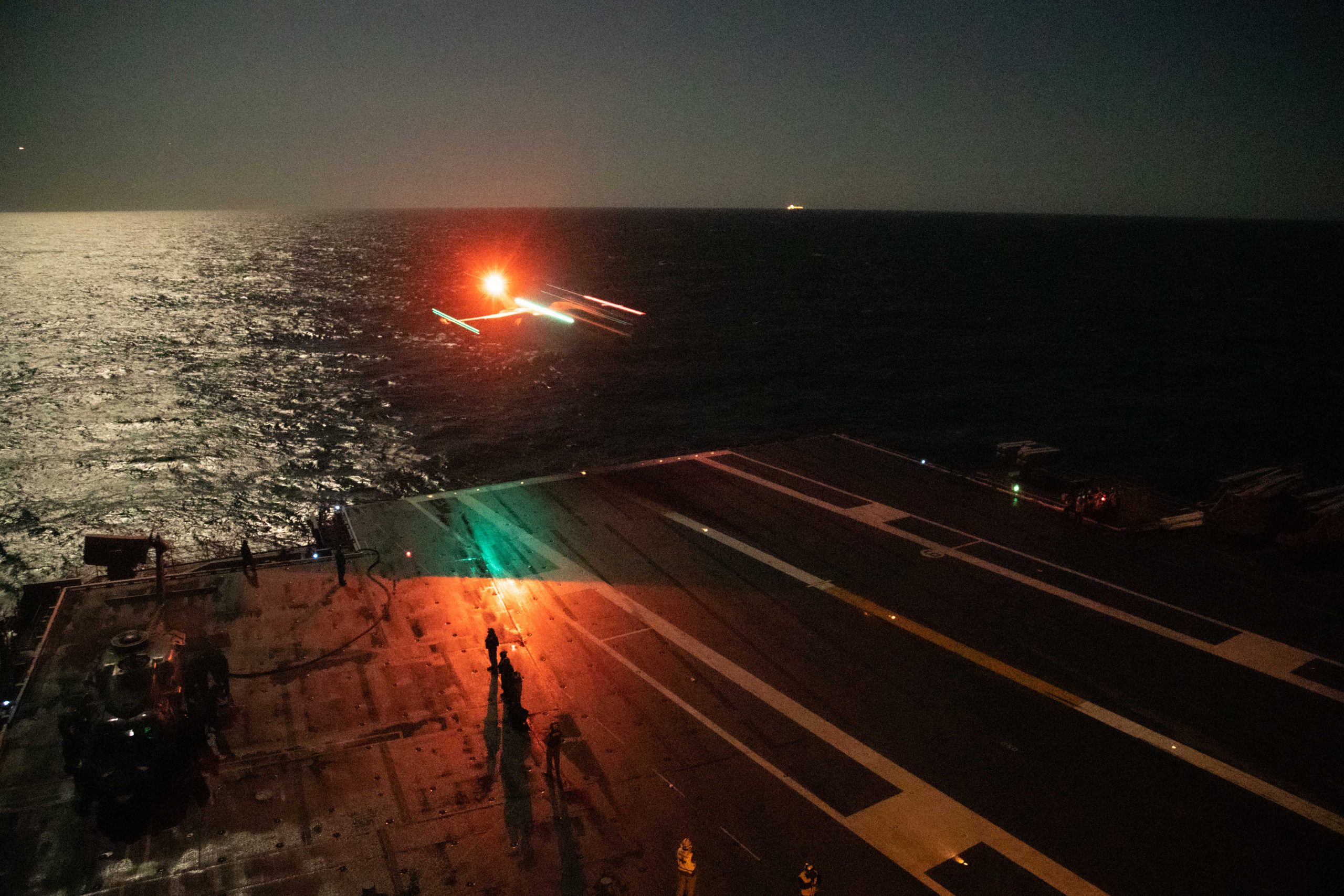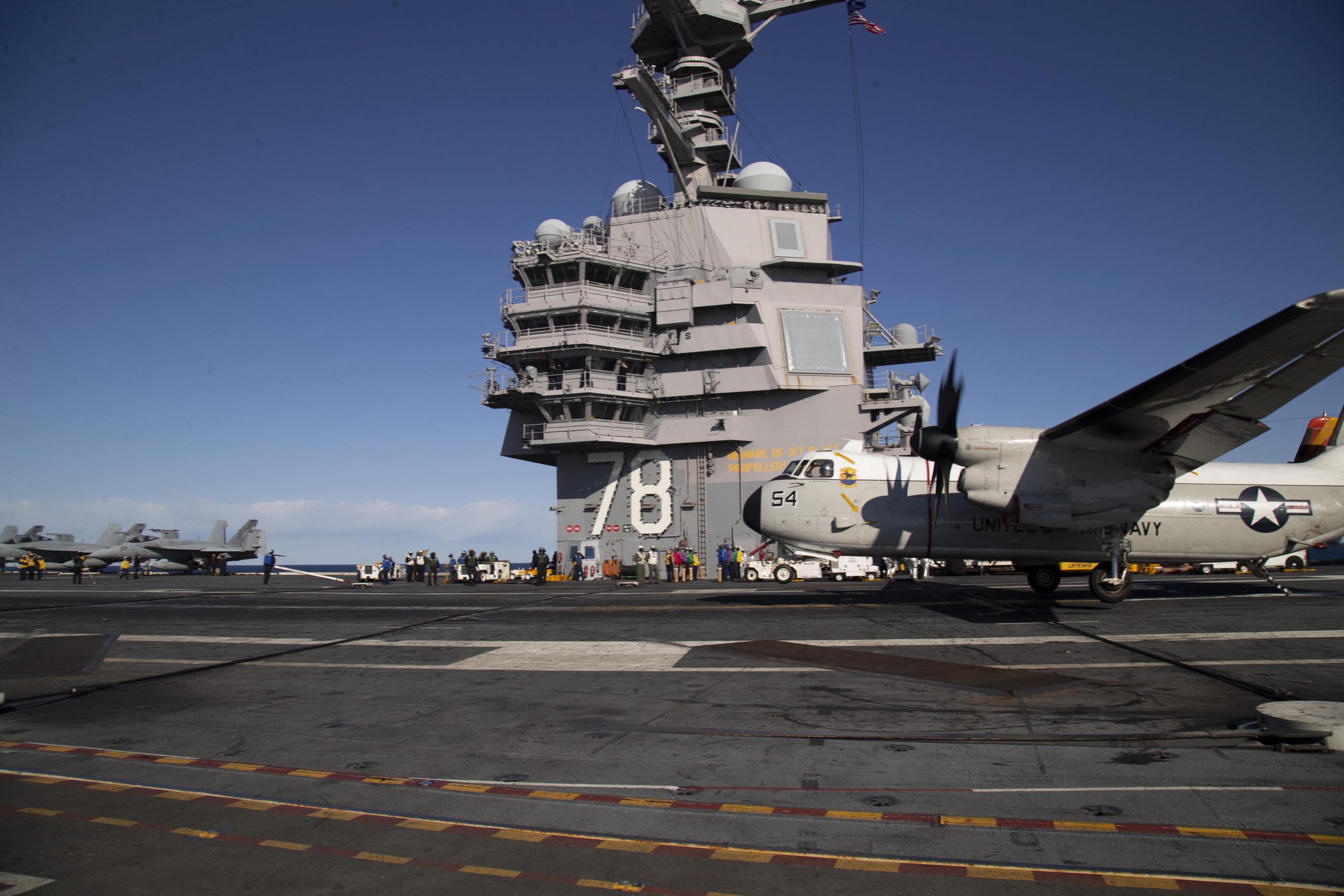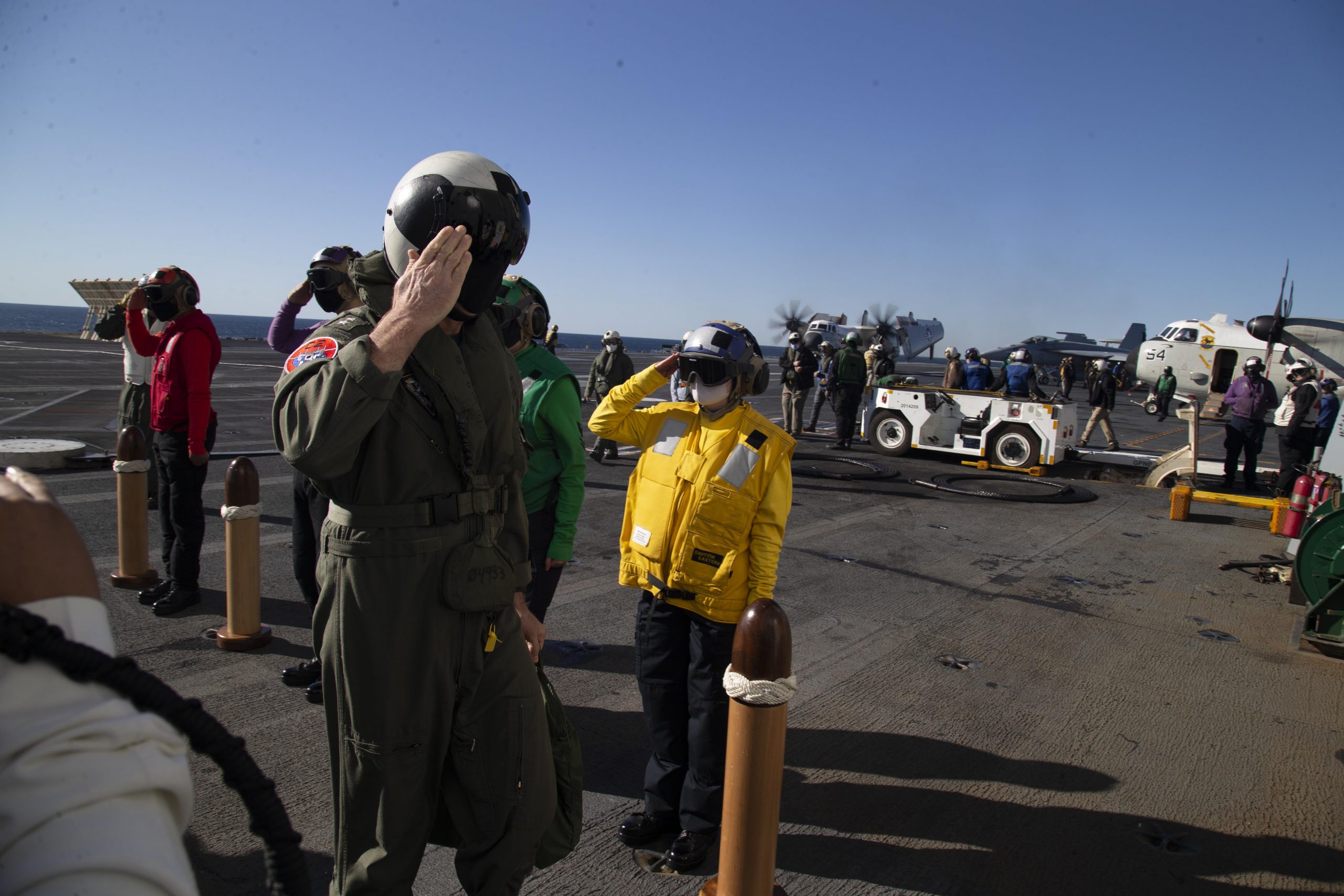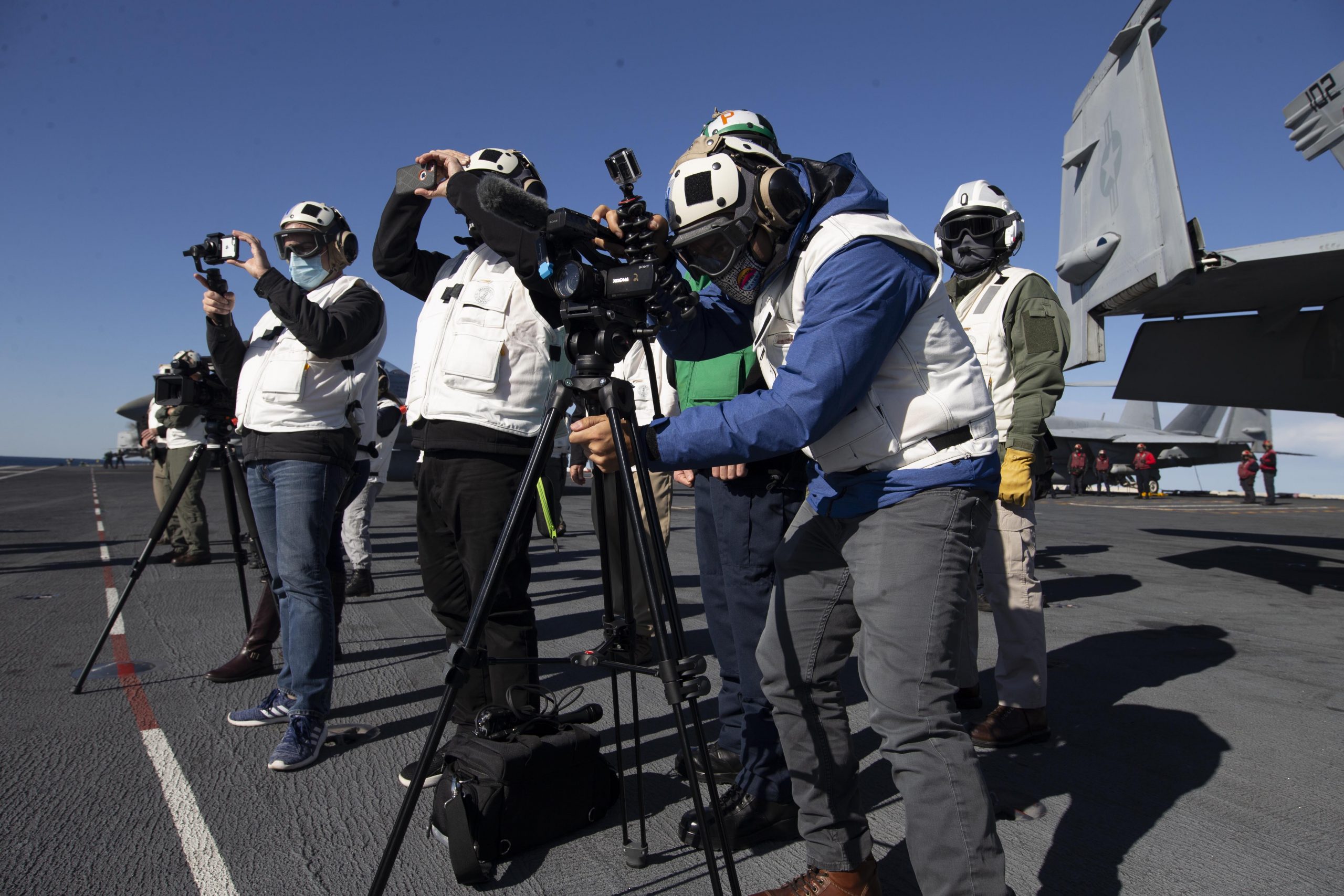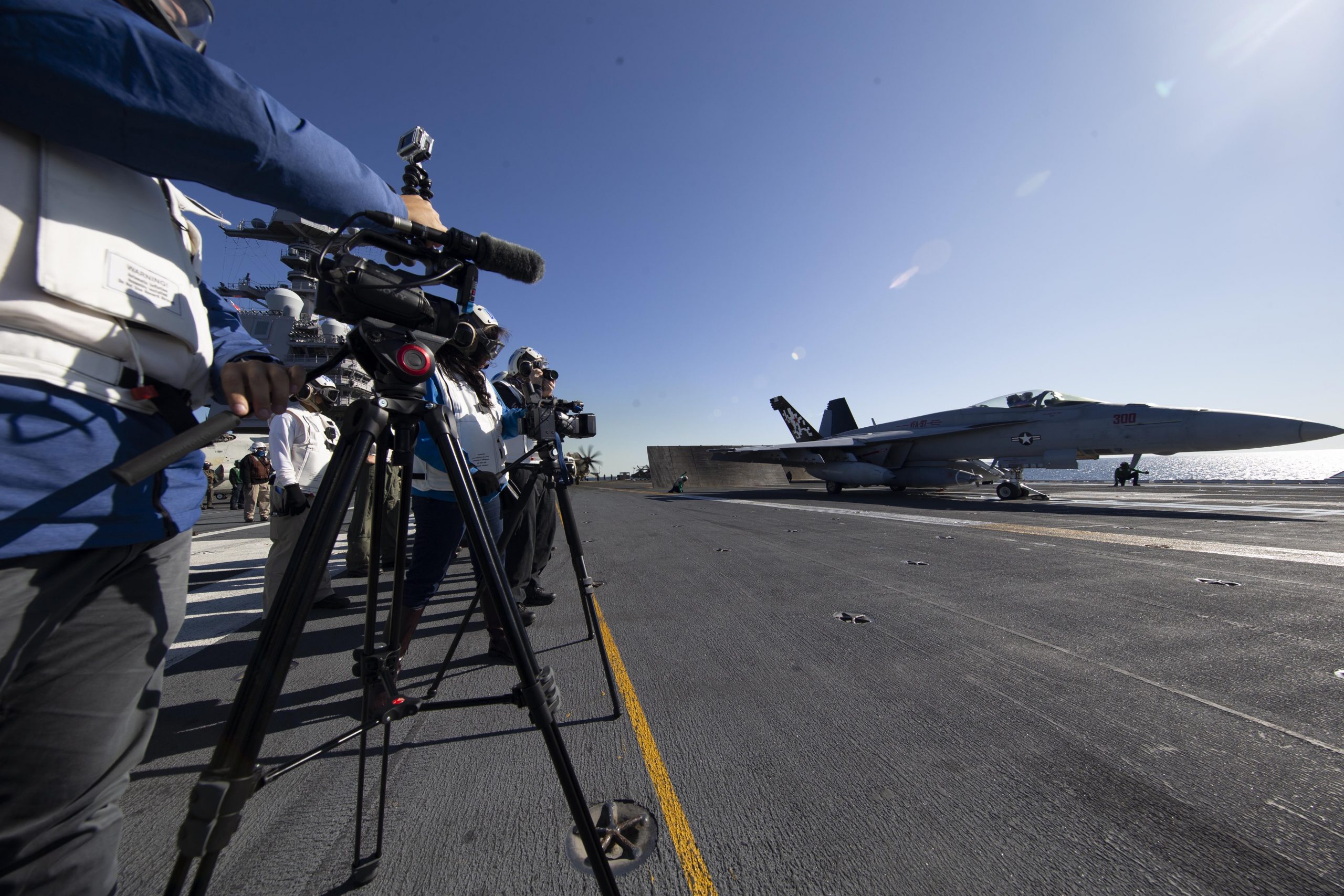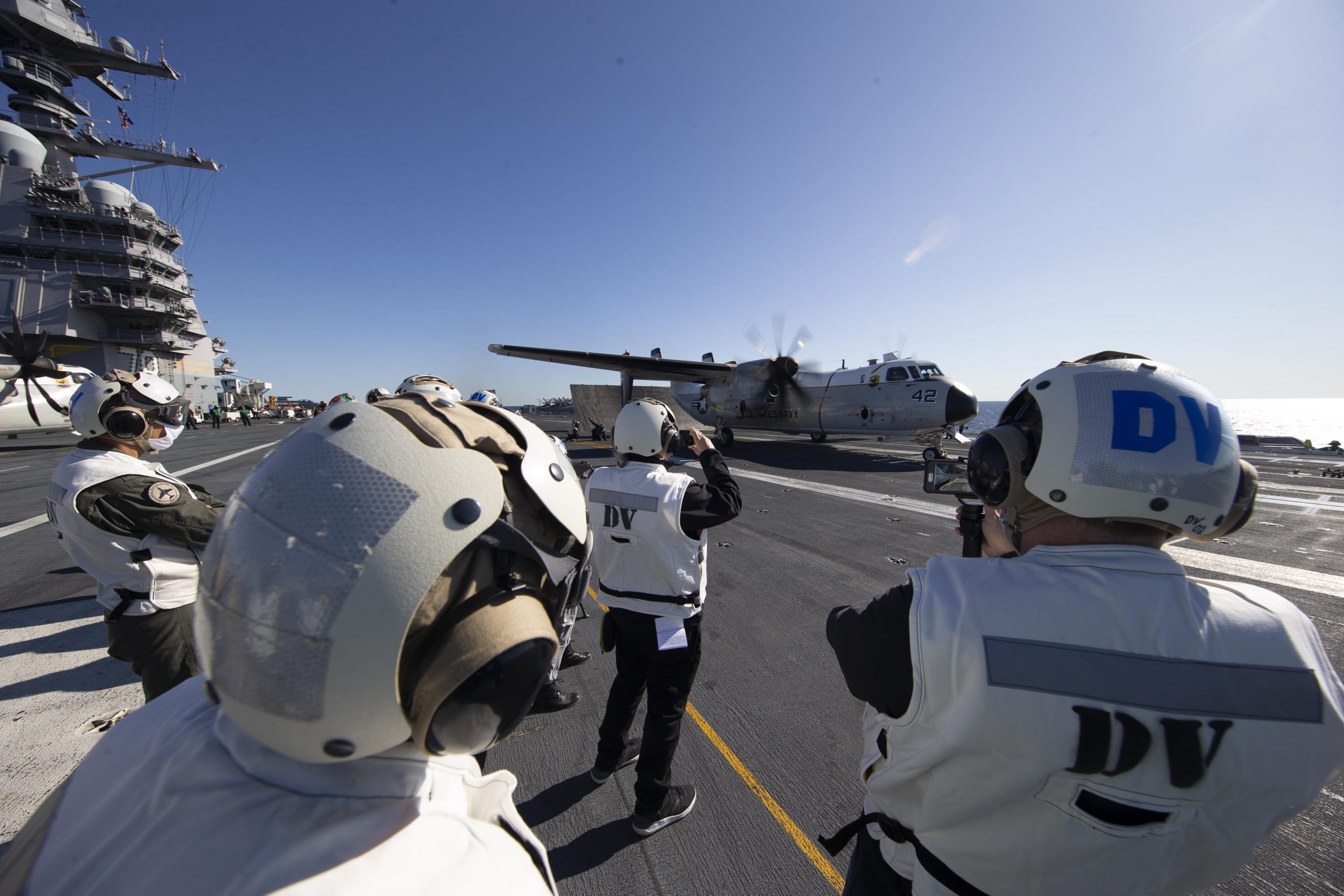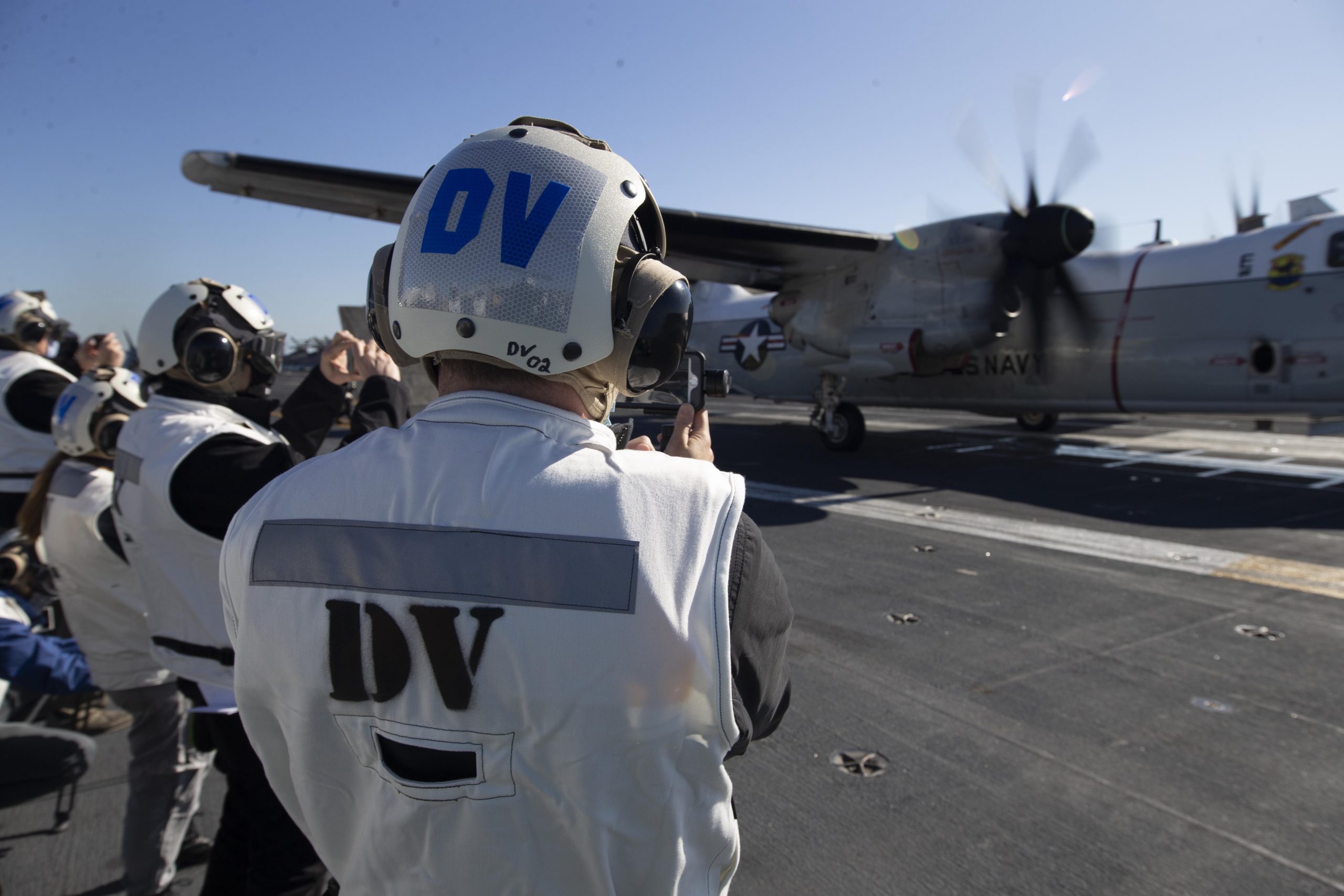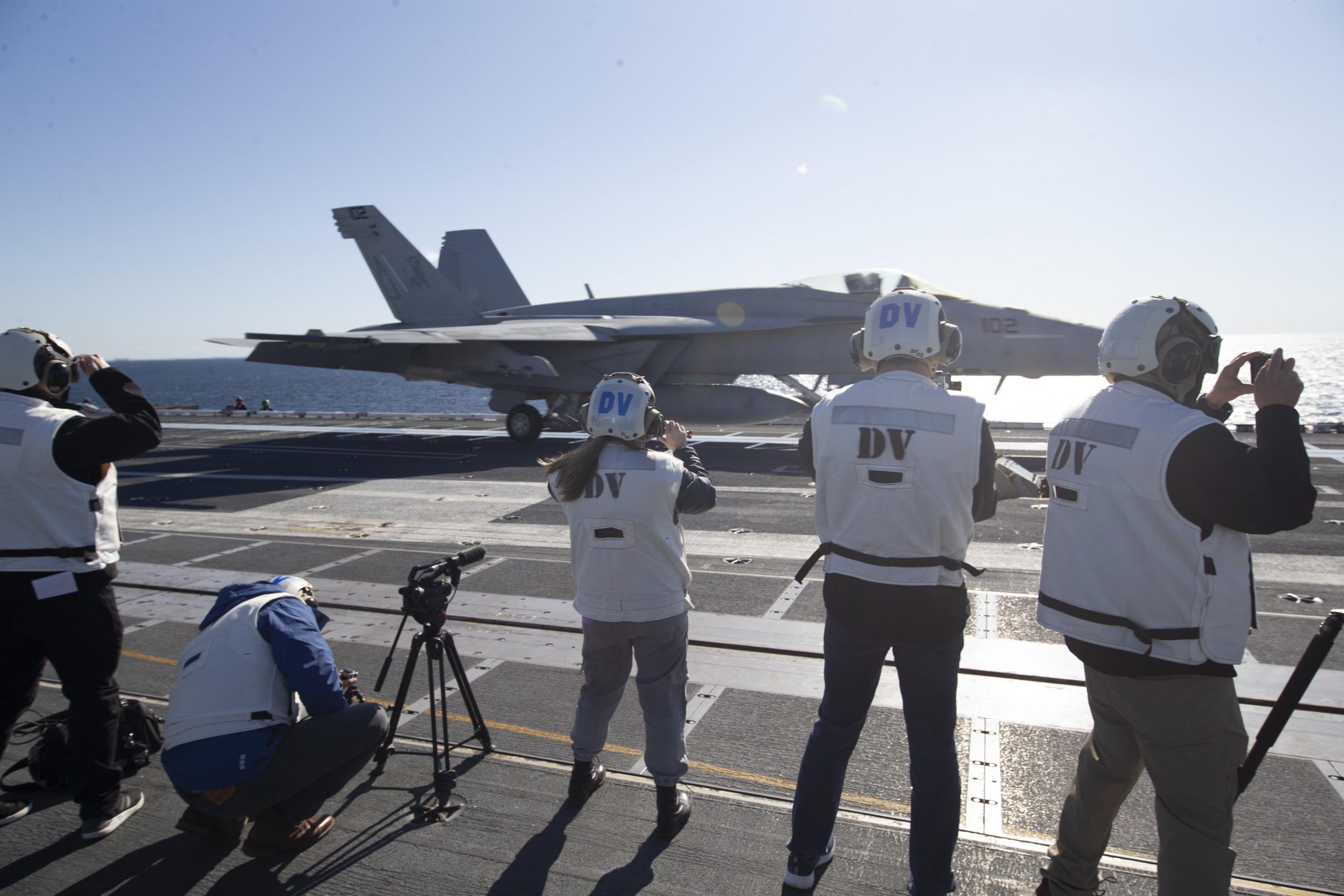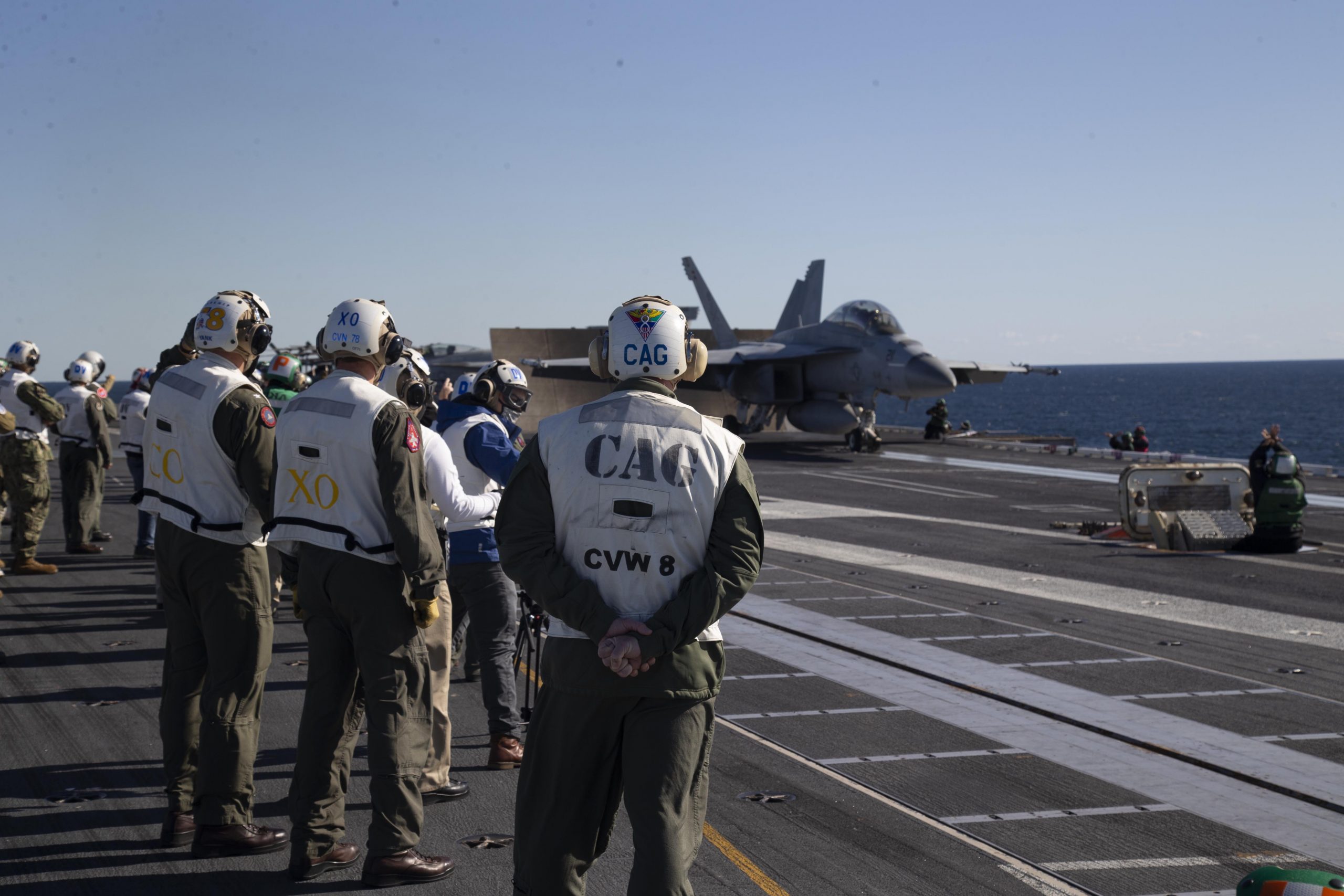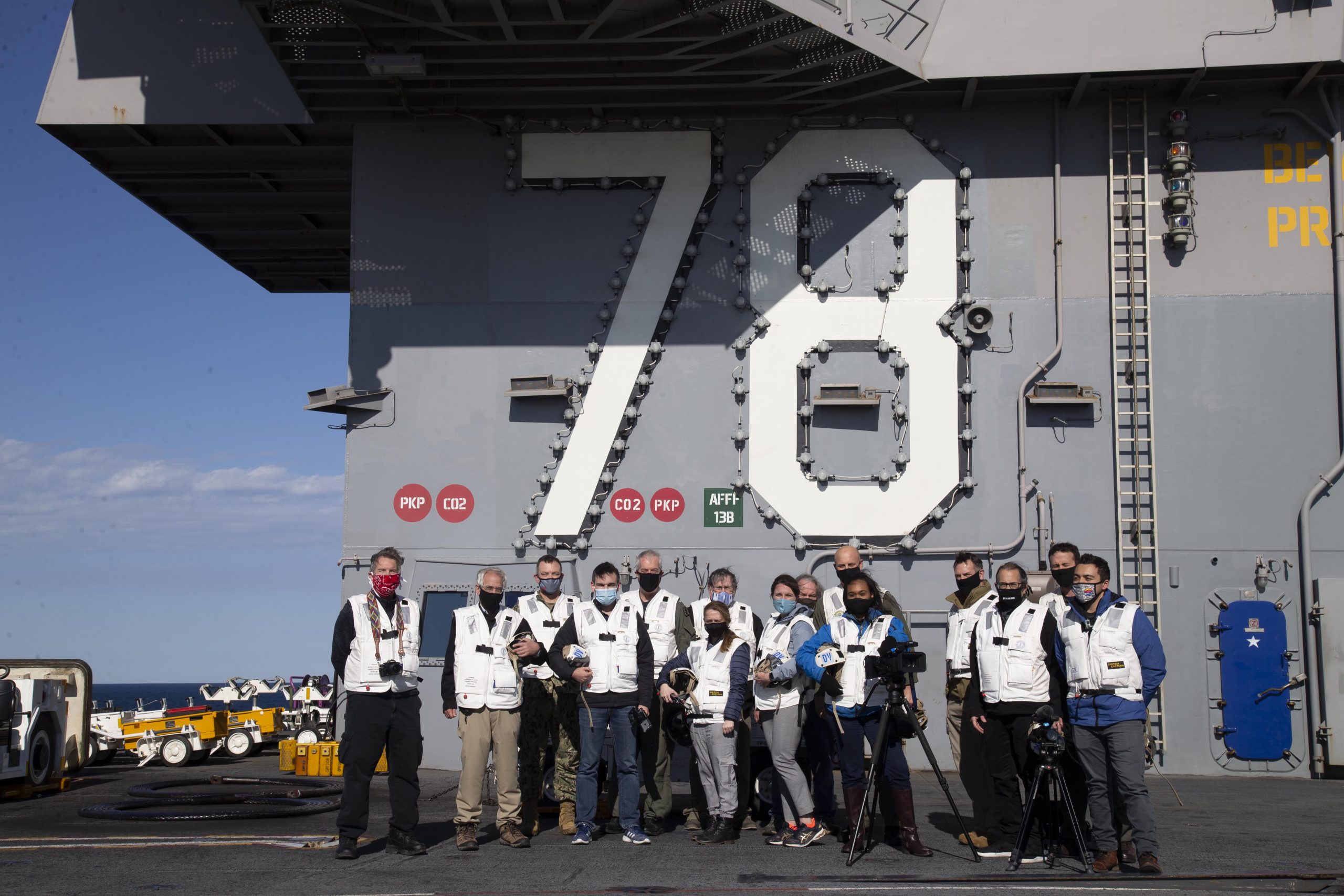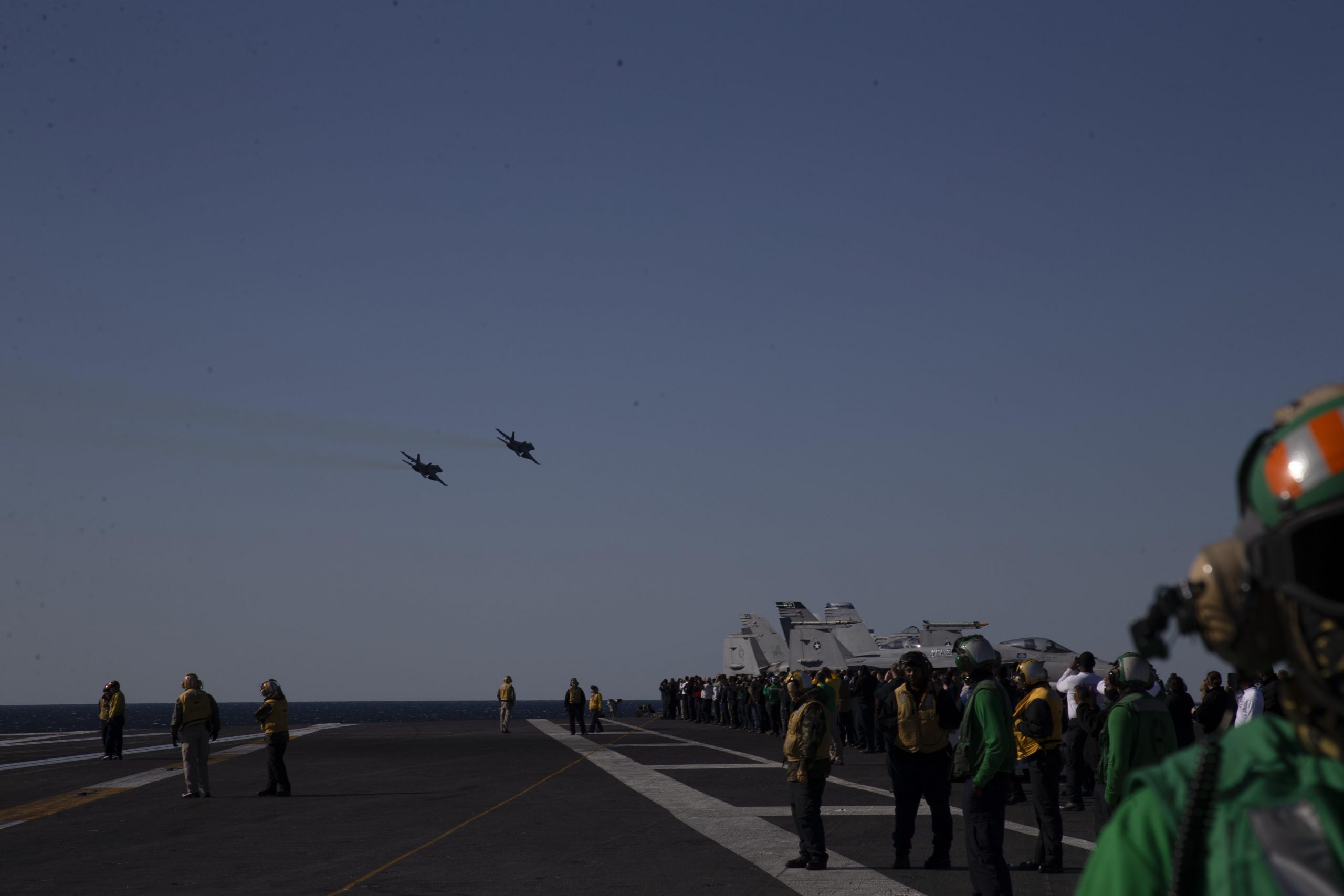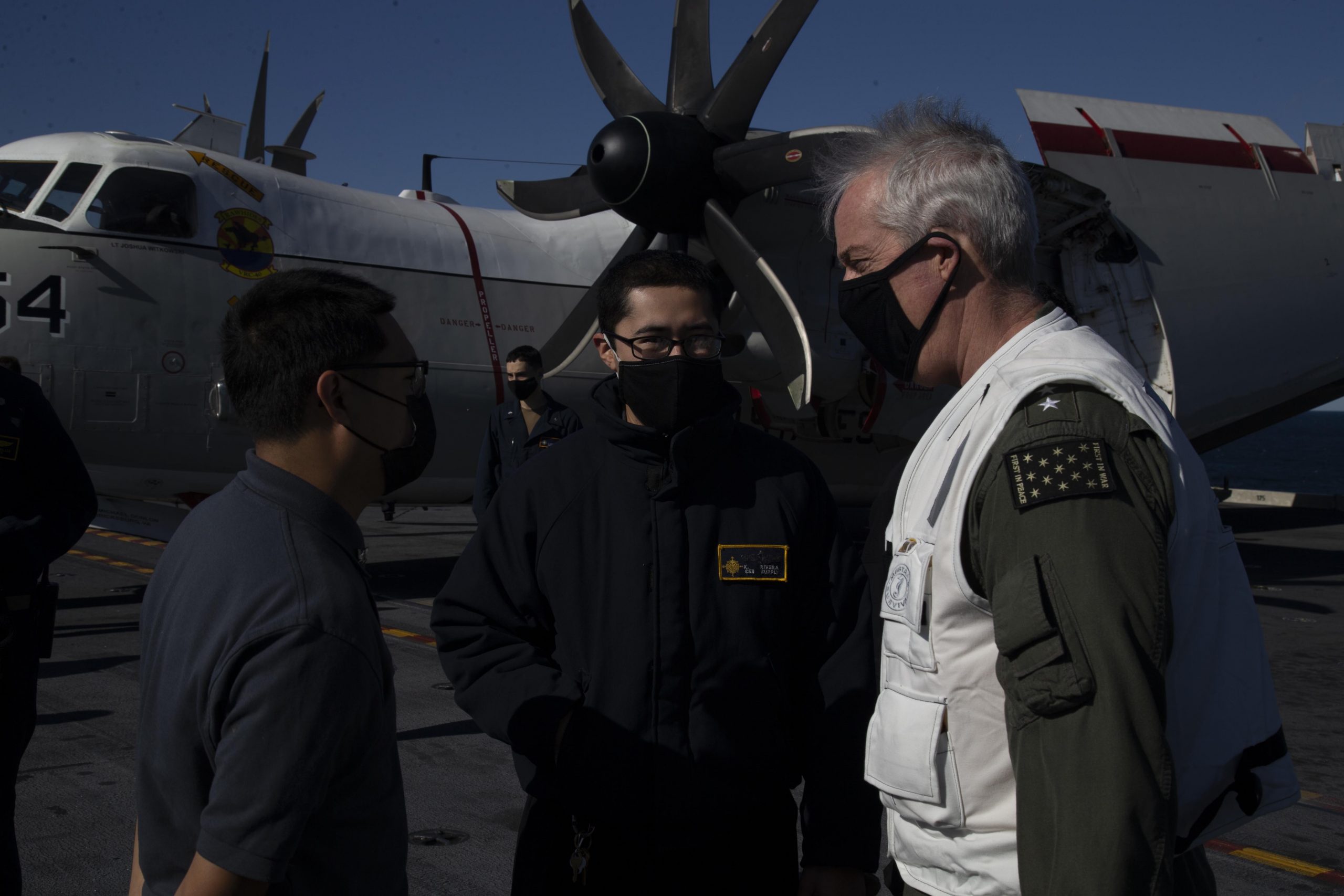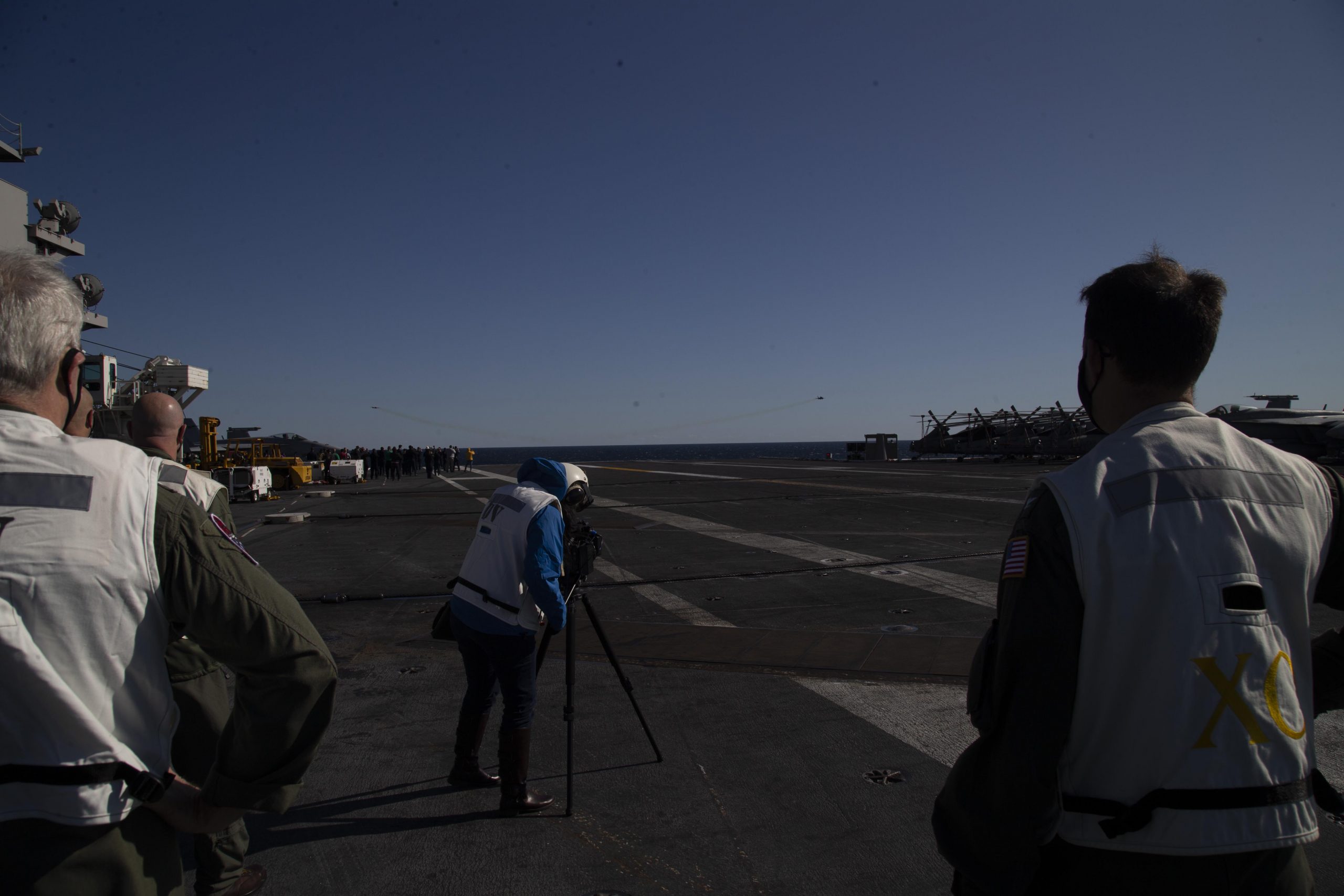By Robbin Laird
On November 17, 2020, a small number of journalists, most from the local Norfolk based media, flew from Norfolk Air Station to the USS Gerald R. Ford at sea, less than 100 miles off of the Virginia cost.
We flew on the venerable C-2 Greyhound, but this was the first time I had done a carrier landing with the advanced arresting gear and the new EMALS launch gear engaged.
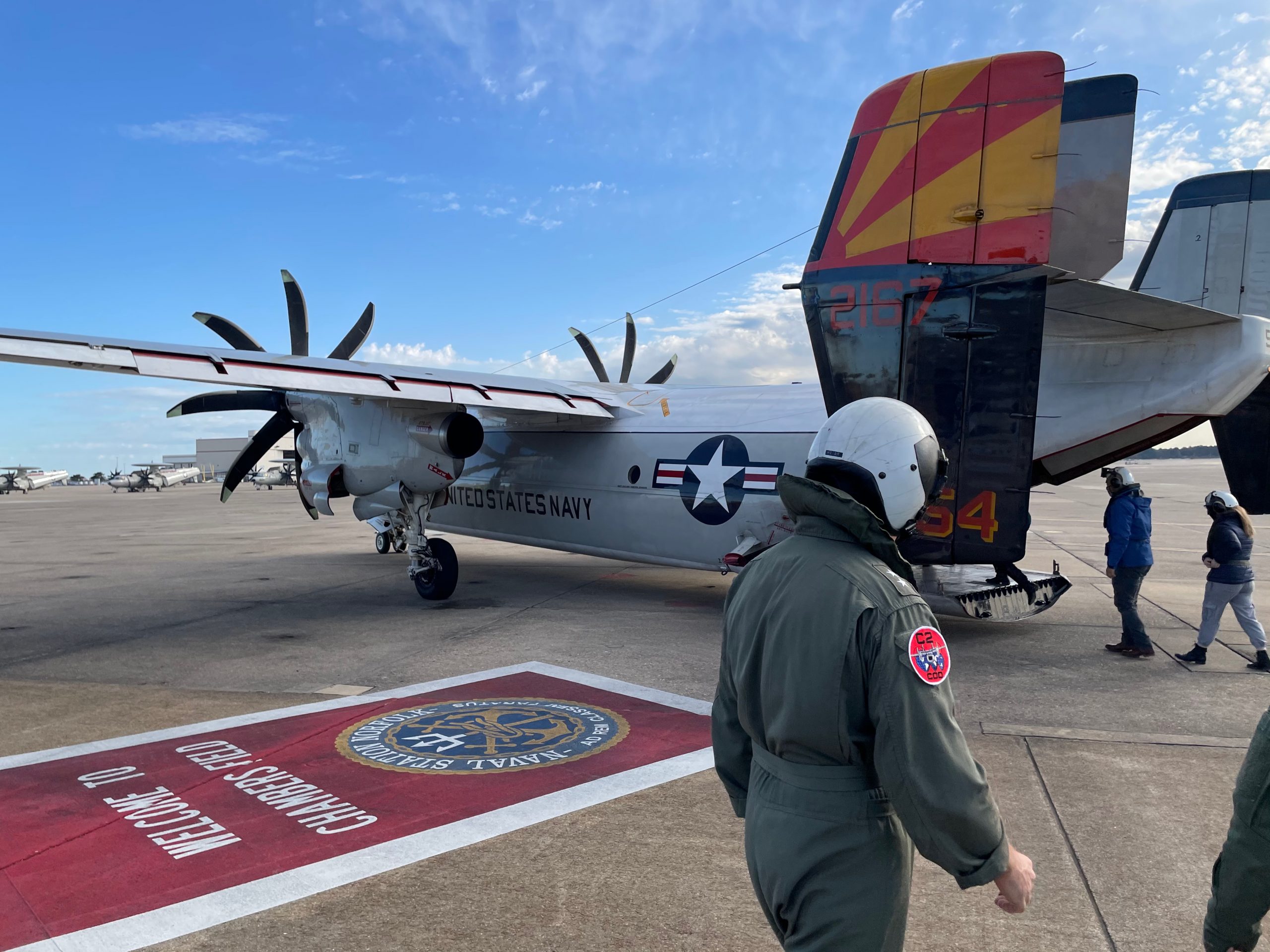
It was clearly different.
Notably, when we launched it was much smoother and much quicker than a steam catapult experience.
Last month, I had spent two days with the senior leadership of USS Gerald R. Ford and talked with many members of the crew.
What I had a chance to see and discuss during that visit was the new combat architecture built into the ship which allows for a very different workflow than a Nimitz class carrier, which facilitates significant advances in sortie generation rates, as well as new ways to manage the deck space in empowering air operations from the very formidable warship.
One of the key changes is with regard to the weapons workflow.
On a Nimitz class carrier, there is a “weapons farm” on the ship’s flight deck from which weapons are worked for assembly and worked with components brought from various levels of the ship and then transported by a hydraulic system which pulls the elevator up with wires and ropes.
The weapons need to be moved through one of the two mess decks before being transported on deck. And prior to loading the weapons onto the aircraft, there is the challenge of finishing the weapons preparation prior to weapons loading.
This process changes onboard the USS Gerald R. Ford.
Below the flight deck are two very large weapons assembly and loading areas, where the weapons are prepared to be transported to the flight deck for loading onto the aircraft. These two large areas allow the ordinance team to prepare weapons of various complexity out of the weather, which makes the process much more rapid and safer.
It is also clear, that the new carrier will be able to operate with significant capabilities to support multi-mission operations. There is enhanced capability for the crew to build diverse weapons packages below deck and then to transport them rapidly to the flight deck for loading.
This will give the ship the ability to mix and match flight strike packages or even ISR packages much more rapidly.
As Rear Adm. Clapperton, Commander Strike Group 12, put it: “We can move more weapons in a safer way, a faster way to a flight deck that is larger and more flexible. And that all contributes to the kind of agility, lethality, and flexibility the Ford brings to the fight.”
The flight deck of the USS Gerald R. Ford is quite different from the Nimitz class carriers.
The island on the USS Gerald R. Ford has been moved 140 feet aft and is 30% smaller.
What this allows is significant additional space for aircraft refueling and weapons loading operations, with the area forward of the island able to accommodate more combat aircraft.
During flight operations, Ford’s design increases the amount of usable space forward of the island and reduces the amount unusable space aft.
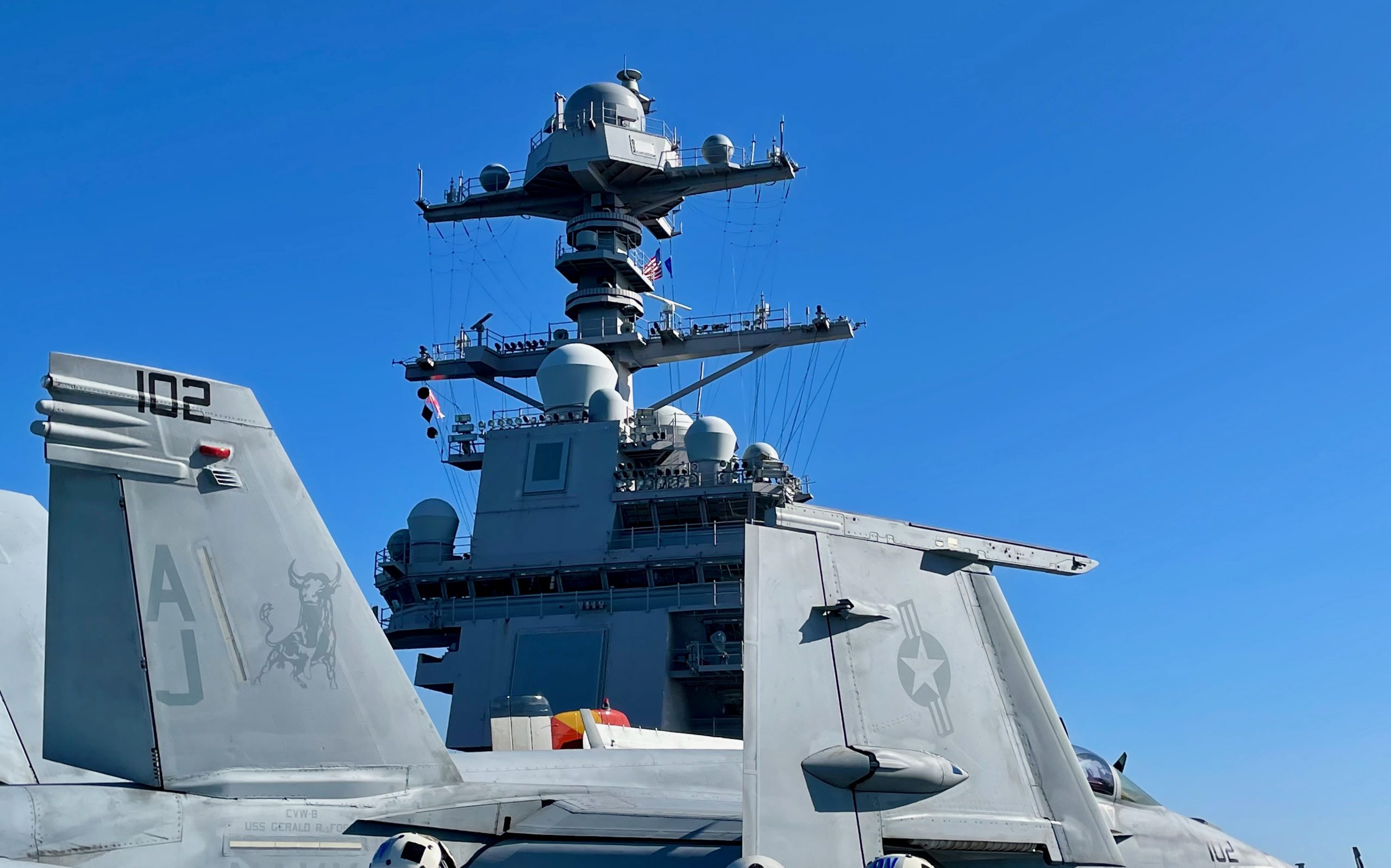
There is more operational space on the USS Gerald R. Ford’s flight deck and the new launch and landing systems as well as a significant redesign of how refueling is done on the flight deck provide key tools for a significant reshaping of the operational tempo for the large deck carrier.
The new launch system allows for a wider range of aircraft to operate from the carrier; the new arresting gear system can recover them.
The ability to mix and match the current air fleet and the future one is significantly enhanced with EMALS. The launch system has a larger aircraft weight envelope that exceeds what is available with steam, so EMALS can launch very light aircraft or heavy aircraft which means this system can accommodate future manned or unmanned aircraft.
The same flexibility exists in the Advanced Arresting Gear with larger current operating wind and weight envelopes and the capability to recover future aircraft designs with minimal modifications required.
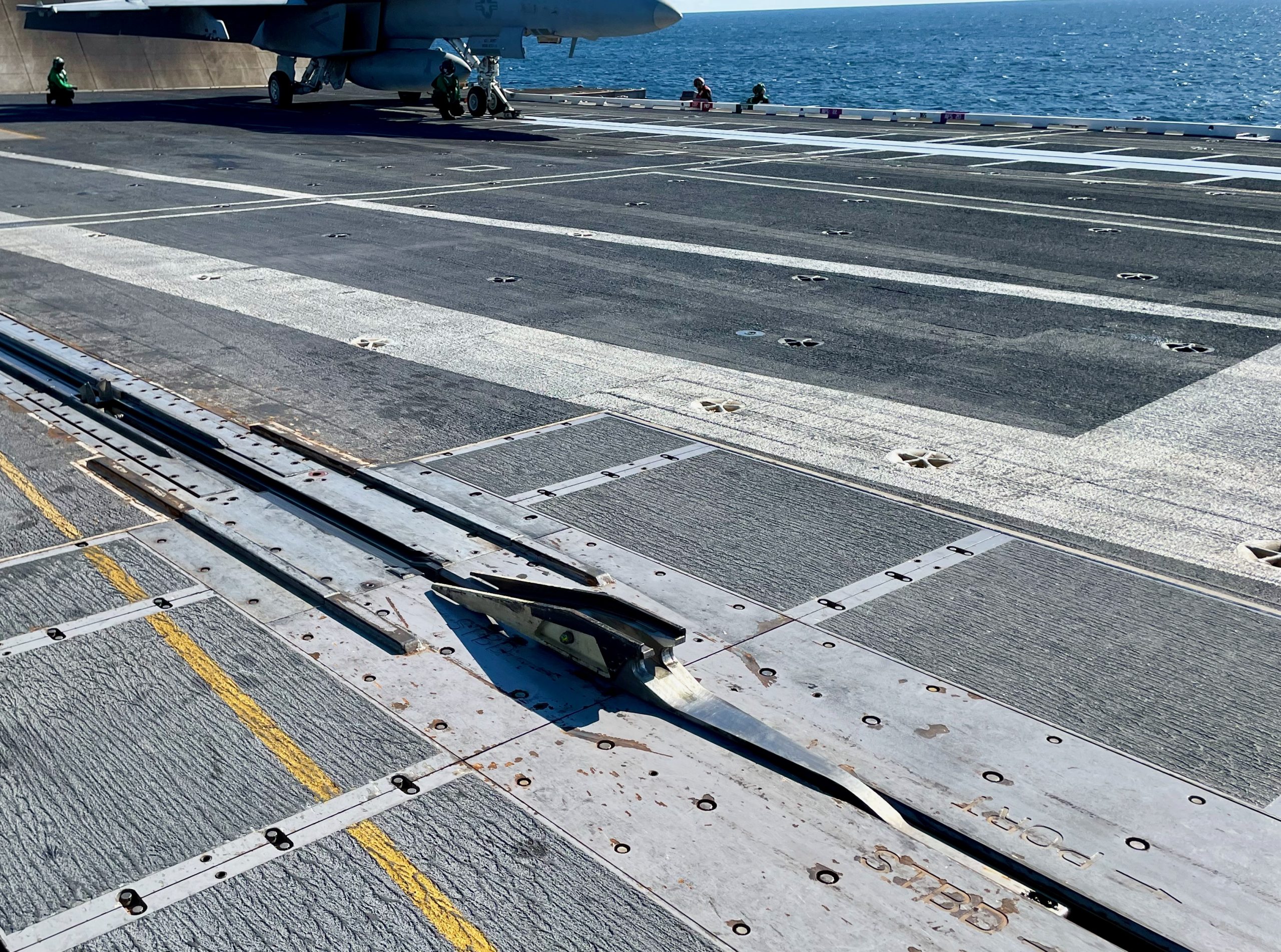
The refueling system is designed to keep a clear path to the catapult by reducing flight deck obstructions caused by refueling hoses, weapons skids and weapons elevator access points. This highly efficient flight deck flow allows for the FORD to sustain higher launch and recovery rates.
The in deck refueling stations which are unique to the Ford keep refueling hoses out of the taxi paths to the catapult. (refueling stations which can refuel two aircraft at the at those stations.
This has a major impact because on the Nimitz the refueling crew has to carry several, lengthy connected fuel hoses which are heavy from the starboard side of the Nimitz class to do mid-deck refueling.
On the Ford, the hoses are right there beside the in-deck refueling stations and rather than having to have a crew of 5 people to bring the hoses 150 feet to mid-deck and do refueling, you only need two crew to man the in-deck refueling stations.
The speed of launch and recovery was on full display during out visit on November 17, 2020.
Currently, the Ford has 2/3 of its airwings on board, with two air wings and four squadrons operating from the deck. The carrier is at sea currently working what the US Navy calls cyclic operations, this is where strike packages are launched in clusters, and then operate in the combat space to provide for the various missions done by the Navy at sea.
Normally, at this stage in the certification of a new carrier, cyclic operations would not be performed, but clearly that is not the case with the Ford.
A crucial aspect of the Ford are the C2 capabilities and roles of the carrier, which I visited in October but not on this visit.
The mission operations areas are much larger than on the Nimitz and are being configured for the kinds of information warfare as well maritime distributed operations which the new carrier will execute at greater distance in blue water maneuver warfare operations.
But what was on the ship at sea, and not visible during the October visit, were the full complement of warfare officers, bringing the various warfare competencies to the command deck.
One notable member was the commander of an Aegis destroyer, as Aegis will have a combat officer onboard the Ford working the various ways Aegis and the carrier will work together in the blue water maneuver space.
One marvelous moment in the visit, after having traversed the cavernous ship for several hours, was sitting down in the briefing room to be briefed by one of the squadron commanders.
This commander gave a rapid-fire brief bristling with information and enthusiasm and one might have missed the historic developments he referred along the way.
For example, I had to ask a question to slow this cutting-edge aviator down to highlight this little gem. On November 9, 2020, the Ford air wings operated with ACC in a counter-air defense exercise with F-22s, and F-15s to shape a joint warfighting package. This obviously would carry with it the C2 collaboration from land to sea in a warfighting training exercise. And again, this is not the kind of exercise one would be expecting for the work up of a new carrier.
But that is really the point.
This is not just a replacement for the Nimitz class carrier this is a whole re-imaging of the large deck carrier being introduced into the new strategic situation and shaping new combat capabilities with the fleet, the joint services, notably the USAF and with coalition partners.
The ecosystem being shaped within which the USS Gerald R. Ford is a key element is so different that Ed Timperlake and I are writing a book for USNI Press entitled the Maritime Kill Web, 21st Century Warfighting and Deterrence.
The photos in the slideshow highlighted the time on deck on the USS Gerald R. Ford on November 17, 2020 with the invited media.
An earlier version of this article appeared on Breaking Defense on November 25, 2020.
The featured photo: An F/A-18E Super Hornet attached to the “Gladiators” of Strike Fighter Squadron (VFA) 106 approaches USS Gerald R. Ford’s (CVN 78) flight deck Nov. 1, 2020.
Ford is underway in the Atlantic Ocean conducting carrier qualifications. (U.S. Navy photo by Mass Communication Specialist Seaman Sarah Mead)
Media Stories Focused on Media Visit November 17, 2020
Mallory Shelbourne, “USS Gerald R. Ford Making Steady Progress Ahead of Deployment,” USNI News (November 24, 2020).
While the current testing period is largely focused on obtaining various accreditations – like Carrier Air Traffic Control Center (CATCC) Certification and Flight Deck Certification (FDC) – Navy officials have emphasized that incorporating strike group operation drills into the PDT&T phase is helping prepare the carrier for operations down the road.
During a press conference in Ford’s foc’sle, Clapperton said warfare commanders within the CSG are all currently operating aboard Ford now.
“We’ve got all four of the major warfare commanders – plus the commanding officer of the carrier and the strike group commander – all out here together. And we’ve really stepped up the level of complexity and integration for the Ford strike group. We are no longer just doing the required test in intervals for the PDT&T session. We are now doing integrated strike group operations very similar to what you would see an aircraft carrier in work-ups doing,” Clapperton said.
“And really this week – last week was a little bit more of the basic phase stuff – this week they’re starting to see a little bit of increase in complexity and full-spectrum operations: air defense exercise, maritime strike exercises, strait transit exercises, [anti] submarine warfare exercises, and combat search and rescue exercises. All that going on essentially simultaneously with this test and evaluation period for the carrier as well,” he added.
Downey said the strike group commander would not typically be onboard the ship during PDT&T and therefore his presence and the ship’s drive to start conducting these strike group operations have changed the order of events in this testing period.
While in the testing stage, the crew uniquely has the chance to experiment with potential changes to how they conduct strike group operations. For example, during USNI News’ time aboard Ford, the strike group’s air defense commander was operating in the Tactical Flag Command Center, where the CSG sits, while Ford practiced a strait transit.
Capt. Corey Keniston, the commanding officer of guided-missile cruiser USS Gettysburg (CG-64), would typically perform his duties while onboard the cruiser, not the carrier. But during this developmental testing, the crew is seeking to learn how Keniston physically operating from the carrier could affect CSG operations.
Dave Ress, Daily Press (November 22, 2020).
But, down in the strike group commander’s dimly lit tactical command and control room, one of the large, glowing bloom screens on the wall displayed the virtual, dog-legged transit the strike group was to pass through, after deploying helicopters to keep the careful watch they’d be making if the Ford were eventually to go through the straits of Hormuz or Malacca. Green blips showed where the strike group ships and other vessels were. The strike group was inside the lines.
Watching was air and missile combat commander Capt. Corey Keniston, normally stationed on the strike group cruiser he commands, USS Gettyburg, stationing this missile command officers on the carrier. He’d be running a missile defense operation once the transit exercise was cover.
Part of what the Ford has been testing over the past few weeks is the idea of having onboard combat control officers from Keniston’s operation as well as the separate information warfare command, responsible for electronic warfare and cyber security operations, Clapperton said.
“We’re flattening the battle space,” Clapperton said, pointing to Keniston, also known as the whiskey commander.
Chris Cavas, “Primed for a Busy Year Ahead, Carrier Gerald R. Ford Will be at Sea More Than Ever,” Defense and Aerospace Report.
In late November the shroud lifted just a bit more, and a small group of reporters was allowed on board for a few hours as the Ford was headed back to Norfolk from 20 days of underway tests. It was the first occasion where media got a chance to visit the carrier while at sea and watch and talk with her crew as they operated and tested their ship.
And it seemed – at least from the few hours we had on board – that a genuinely new spirit is around the ship and the program. In Washington the Ford class effort is often characterized as doom and gloom, rife with concerns and intense oversight. But on the Ford herself folks seemed determined to make it work.
Hope Hodge Seck, “Here’s Why Sailors on the Carrier Ford Will Eat Better Than Anyone Else in the Fleet,” Miliary.Com.
Regarding food, one of the most significant changes on the Ford is the ship’s two galleys, compared with the Nimitz’s five. According to Navy officials, these include a centralized galley to the aft of the aircraft and a forward galley that will be manned only when the carrier’s air wing is aboard. While this means the ship’s food service crew will be more centralized and the mess they dish up more consistent, it also means that officers, chiefs and enlisted sailors will be eating the exact same food — even though they still eat on different mess decks.
Alex Littlehales (WVEC), “For the first time since the pandemic, an inside-look at the progress of USS Gerald R. Ford,” 13NewsNow.
For the October 2020 report, see below:


